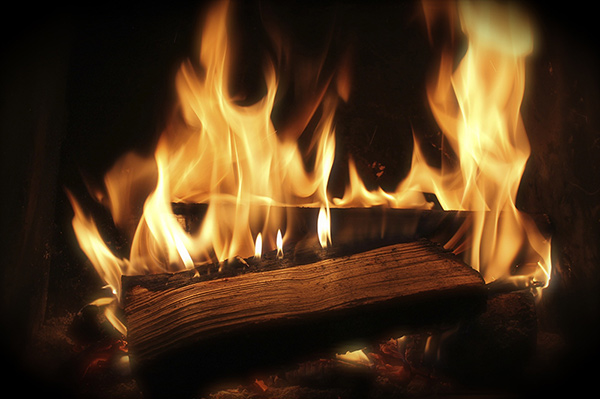
There are few things as relaxing as sitting next to roaring fire. That is, of course, assuming you aren’t startled by a sudden, audible bang with a cloud of soot and smoke filling your room. If you’ve never experienced this, count yourself lucky! Whenever your appliances – from fireplaces to stoves – push their smoke back into your room instead of appropriately exhausting through the flue, this is called “back puffing.”
Because each case of a fireplace or stove back puffing is unique, it’s not uncommon for the frequency and intensity to be hard to track. Sometimes you will only notice a puff back once per season, while others may stop using their appliances due to smoke problems every time they start a fire. Read on to learn about some of the causes for stove and fireplace back puffing, along with tips for identifying the source and solving the problem.
What Causes Fireplace Back-Puffing?
There are several reasons a fireplace or stove may begin back-puffing. Here are some of the most common:
Creosote Build-up in the Chimney
Whenever you use your fireplace, smoke leaves a byproduct that coats the interior of your flue. This byproduct is called creosote. As you continue to use your fireplace, creosote buildup grows thicker and thicker. Because creosote is highly flammable, and because the buildup reduces the functional size of your flue, creosote creates a significant hazard.
Because of the creosote, your chimney will generate more smoke than can be exhausted, leading to the smoke traveling the path of least resistance: into your room. A CSIA-certified chimney sweep can inspect and identify creosote buildup for you. If this is the case, you will need to have your chimney swept, which will remove the buildup and restore your chimney to its peak working condition.
Inefficient Pipe Layout
Smoke should be able to flow out as vertically as possible. Any turns in the flue or pipe add resistance to the exiting smoke. If your home’s venting system was designed with numerous elbows, each one impacts your stove or fireplace’s ability to vent. Horizontal pipe is exceptionally inefficient, and can cause serious problems.
Poor Air Supply in the Home
While most homeowners commonly feel like more insulation is better, a tightly-sealed home can actually “suffocate” your stove. Fire requires oxygen to burn, so when your home is too tightly sealed, it limits the flow of air into the fireplace.
This problem is often easy to identify. If you recently had new doors or windows installed, and then noticed a back-puffing issue, try introducing airflow to the fireplace when it’s burning. Open a nearby window before you start your next fire. If it functions normally, it means your home lacks the airflow necessary to safely feed the fire.
Obstruction in the Chimney
If the chimney is obstructed, it will restrict the airflow. When this happens, the smoke will build in the flue pipe until it’s forced to exhaust through the fireplace or stove. These can range from the typical branches or birds’ nests in your chimney, to more unusual items like balls or wasp nests. Without annual chimney inspections, you’re only likely to notice the obstructions when you begin to experience fireplace back puffing.
Fortunately, obstructions are easily solved. Contact a qualified chimney sweep to inspect and sweep your chimney. Once the obstruction is removed, your fireplace or stove should work normally again.
Cold Air in the Chimney
If it’s cold outside, particularly during a rain, the cold air can prevent the smoke in your chimney from being able to escape. Because it can’t go up-and-out due to the heavier cold air, it will travel in the opposite direction – right into your home. When this is the cause of your fireplace or stove back-puffing, the problem should solve itself after the air warms up. However, that still leaves you cleaning up the initial mess.
You can stop this cold air from blocking your chimney by priming the flue. This can be done simply using a newspaper. Roll up the newspaper and ignite it on one end, while holding onto the other end. Stick the lit paper up high into your chimney and let the heat fill the space for about a minute. You should notice the smoke rising into the flue. That’s your sign that you’re ready to light the fire.
Overly Dried Firewood
The ideal seasoning for firewood is between 12-18 months. Any less and it won’t burn as well as desired, but any more and you might run into other issues. Drier wood breaks down more quickly when its heated. In most cases, this is ideal. But because exceptionally dry wood produces more smoke, it’s easy for intense fires to overwhelm your flue system with too much to exhaust – leading to your fireplace back puffing.
There are a few solutions to dealing with overly dried firewood. The first is to make sure that you’re always using properly seasoned wood. Don’t leave old wood out too long. If you do have wood that’s dried for closer to two years, use larger pieces. A bundle of small wood pieces will have more total surface area than a few large logs. Using larger pieces will help reduce the smoke generated, saving you from a smoky mess.
Every Back-Puff is Unique
The most important thing to remember when dealing with fireplace back-puffing is that almost every case is unique. While these issues listed here are common and often easily solved – there are a handful of other cases that can cause you to experience a back puff. Often, it’s a combination of multiple factors leading to the problem. If you want to safely deal with your back-puffing issues, the best solution is to always trust a CSIA-certified professional to inspect and identify the source.
The Importance of Dealing with a Back-Puffing Fireplace or Stove
While back puffs may just sound like a nuisance, they can cause real damage to your home. Depending on the severity of the problem, the smoke pushing back into your room can be corrosive to anything that it touches. In addition to the off-putting smoky smell, particles from the puff back can become embedded in curtains, carpets and even your clothing. They’re not easy to clean away, and contaminate the air with dangerous carcinogens.
However, the most important thing to remember is that an improperly-functioning chimney can cause a build-up of carbon monoxide in your home. Because you can’t smell or see it, you often can’t recognize the problem until you experience symptoms of CO poisoning. If your fireplace, stove or chimney has problems venting – don’t wait to contact an expert!
Fix Back Puffing Problems Today – Call Doctor Flue!
We can thoroughly inspect your chimney and fireplace to identify the source of your fireplace back puffing problems. Contact us today so you can go back to enjoying your fireplace or stove!
Call Us: 1-800-438-3583
Email Us: office@drflue.com
Office Hours: Mon-Fri: 8am-4pm
Connect with Doctor Flue on Social Media

